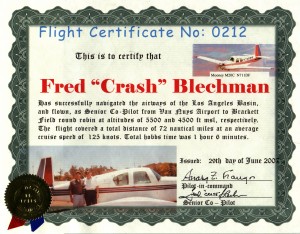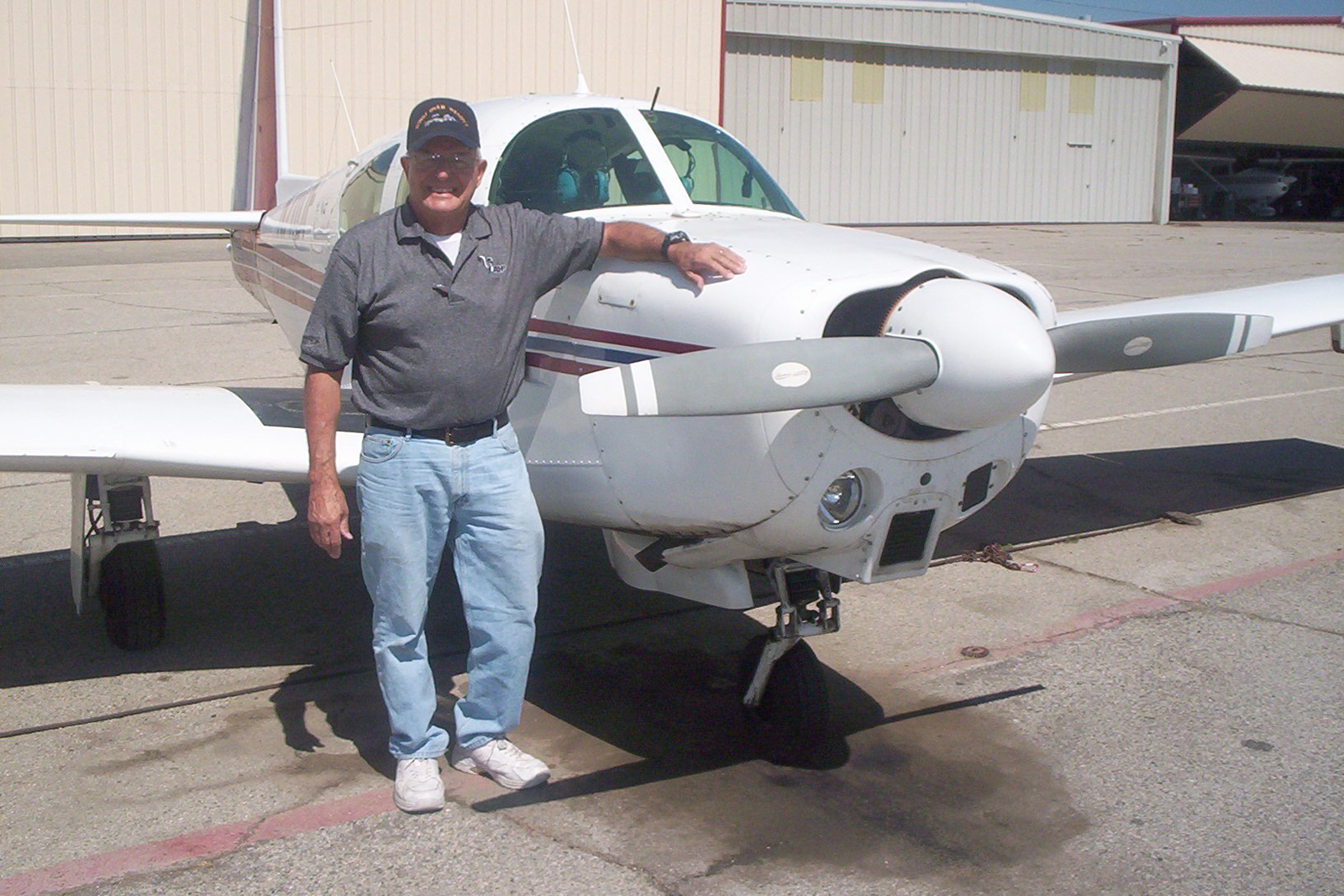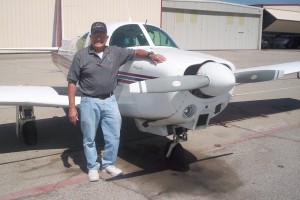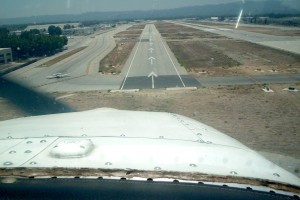By Fred “Crash” Blechman
I have flown into so many airports in Los Angeles, Ventura, Santa Barbara, Riverside, Orange and Kern counties, with so many different pilots and airplanes, that I was looking for a “new” pilot, a “new” airplane and a “new” airport. I found all three on one flight.
I hadn’t flown with 80-year-old Anarg Z. Frangos. On June 25, 1945, five days before he was 18 years old, he joined the Navy while we were at war with Japan. About seven weeks later, the Japanese surrendered.
“My mother always said the Japanese heard I was coming!” Anarg explained.
With master’s degrees in mechanical engineering from the University of Pennsylvania and engineering from the University of California, Los Angeles, Anarg was a professional engineer working in the aerospace industry until his retirement from engineering in 1990. Before and since his “retirement,” he’s done accident investigation for insurance companies and has taught stress analysis, thermodynamics and heat transfer for 28 years in the engineering department at Cal-State Northridge part time. Since 1990, he’s been a middle school and high school substitute teacher for the Los Angeles Unified School District.
At the age of 5, Anarg loved to pretend he was a World War I fighter pilot, but he never flew in an airplane until he was 25. In 1957, at the age of 30, he earned his private pilot license. He’s logged about 3,000 hours since then. Half of those hours were flown in a fully IFR-equipped Cessna 172 he bought new in 1969 for $18,000. The remaining hours have been flown in the Mooney he now owns. He’s instrument rated, so I figured it would be safe to fly with Anarg, who was brave enough to offer to go up with a guy whose call sign is “Crash.”
As for the “new” aircraft, Anarg bought his 1963 Mooney M20C “Ranger” in 1981. N711DF is a fully instrumented, single-engine, low-wing, fighter-like, four-place, tricycle-gear beauty that looks like new. It’s smaller than a Beech Bonanza, and it takes some physical dexterity to enter and leave the cockpit, but once inside, it’s comfortable and offers fine visibility above and around.

Anarg Frangos awarded flight certificate no. 0212 to “Crash” a few days after the flight to Brackett Field.
We met at Mike’s Avionics on the west side of Van Nuys Airport, where we climbed into N711DF and buckled up. Anarg started up the Lycoming O-360 4-cylinder, 180-hp engine, contacted ground control and taxied out to Runway 16R behind four other aircraft. It took almost 10 minutes before Anarg received takeoff clearance from the tower. He lined up with the runway and poured on the power for takeoff.
We were off the ground in less than 15 seconds, at 85 mph and “25 squared” (25 inches of manifold pressure and 2,500 propeller revolutions per minute). Gear up! Our departure was at 10:50 a.m., with VFR clearance to Brackett Field in La Verne, which is northwest of Ontario Airport, roughly east of downtown Los Angeles.
I took the controls and took a heading of 120 degrees, passing over Bob Hope Airport in Burbank and climbing at 100 miles an hour. Anarg requested “flight following,” for controllers to keep track of our flight on radar by the “squawk code” (identifying frequency and code) of the airplane’s transponder. Continuing on this heading, we soon passed over the Griffith Park Observatory, where I turned left to a heading of 090.
When flying VFR eastbound, you should be at an odd number of thousands of feet, plus 500 (this is easy to remember, since “EASTerners are ODD!”). It was very hazy at 3,500 feet, so I continued climbing to 5,500 feet, but the forward visibility was still very hazy. Cruising at 140 mph, the mountains in the distance were visible, but gray, rather than sharply defined. We could see straight down and to the side for several miles as we passed over South Pasadena, paralleling the Foothill Freeway on our left and the San Bernardino Freeway on our right.
As we approached Brackett Field, Anarg took the controls, and we descended rapidly to enter the traffic pattern at 2,000 feet, made a left-hand approach and had a smooth landing at 11:20 on 26L. It had been a half-hour flight. We taxied to a tie-down area near Norm’s Coffee Shop, where an inviting green awning covered the patio on this warm, sunny day. A slight breeze made the setting comfortable, so rather than dining inside, we stayed on the patio. Not only was it comfortable, but we could watch all the planes taking off and landing at this relatively busy airport.
Norm’s menu isn’t only extensive and reasonably priced (with breakfast served all day), but the portions are large! Anarg ordered a “short stack” of two pancakes, and he could finish only half. I ordered a grilled ham and cheese sandwich, which came with fries, and ended up taking half the meal home. And the waitress kept refilling our “bottomless” soft drinks.
Anarg is such an interesting guy; we chatted for more than an hour before finally heading back to Van Nuys Airport at 12:50. Again, Anarg was brave enough to allow me to take the controls after takeoff from 26L. We climbed to 4,500 feet and flew back, westbound through the haze—now worse because of the sun’s position ahead of us.
Our flight path was just the reverse of our flight to Brackett, but the flight time was 10 minutes less—only about 20 minutes. We must’ve been going to Brackett with a slight headwind from the east and had a slight tailwind returning to Van Nuys. Anarg brought the Mooney in to a smooth landing on VNY’s 26L, got clearance to taxi across 16R, parked at his spot at Mike’s Avionics and added another 40 minutes to his flight log. Neither of us was hungry or thirsty for hours!
A few days later, Anarg handed me a beautiful bordered flight certificate. I should’ve given him a medal for flying with me, knowing I had crashed five F4U Corsairs in my Navy flying days!
Fred “Crash” Blechman’s two flying books, “Bent Wings – F4U Corsair Action & Accidents: True Tales of Trial & Terror!” and “Flying with the Fred Baron,” are available at [http://www.amazon.com]. You may contact him by e-mail at crash@airportjournals.com













